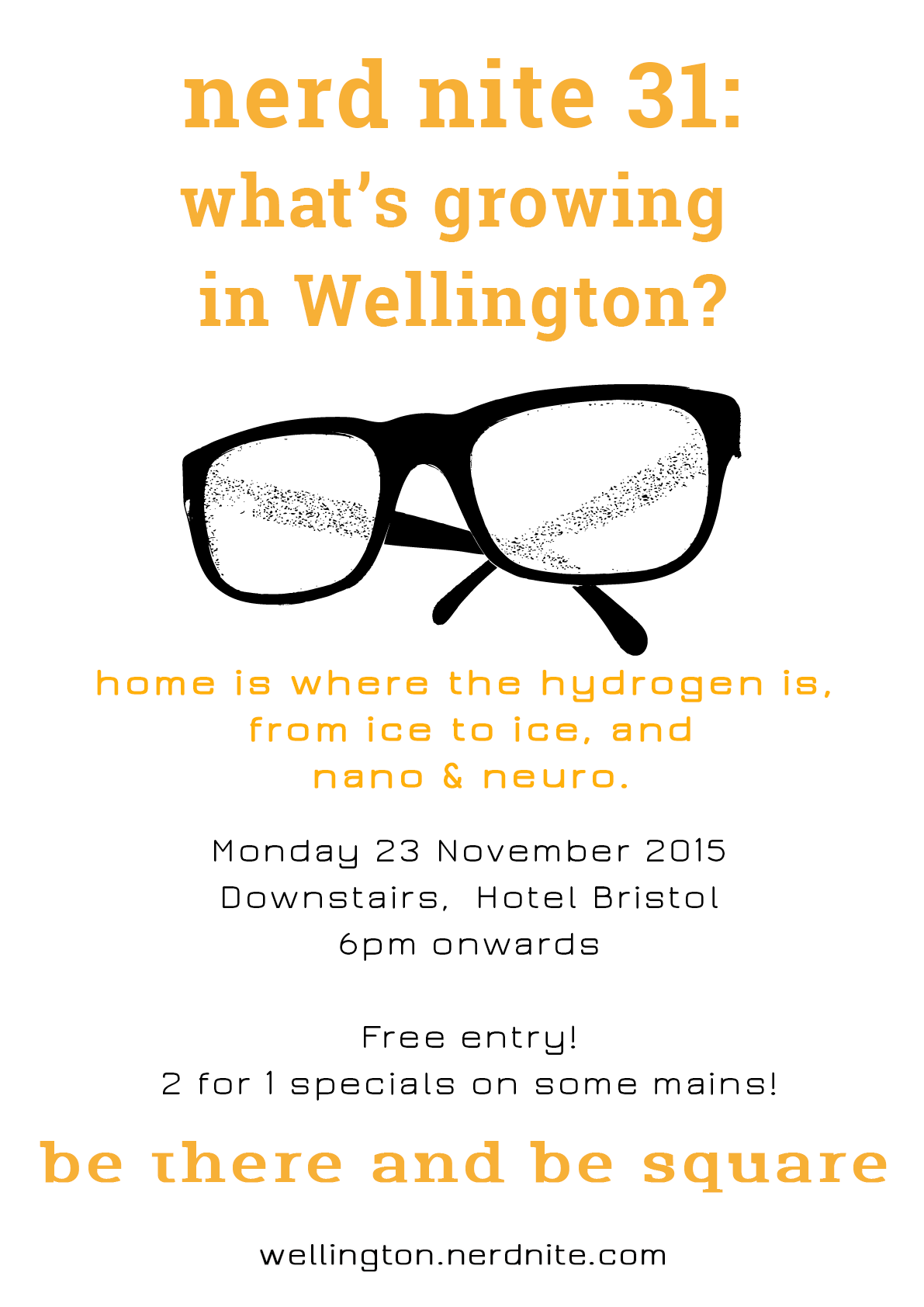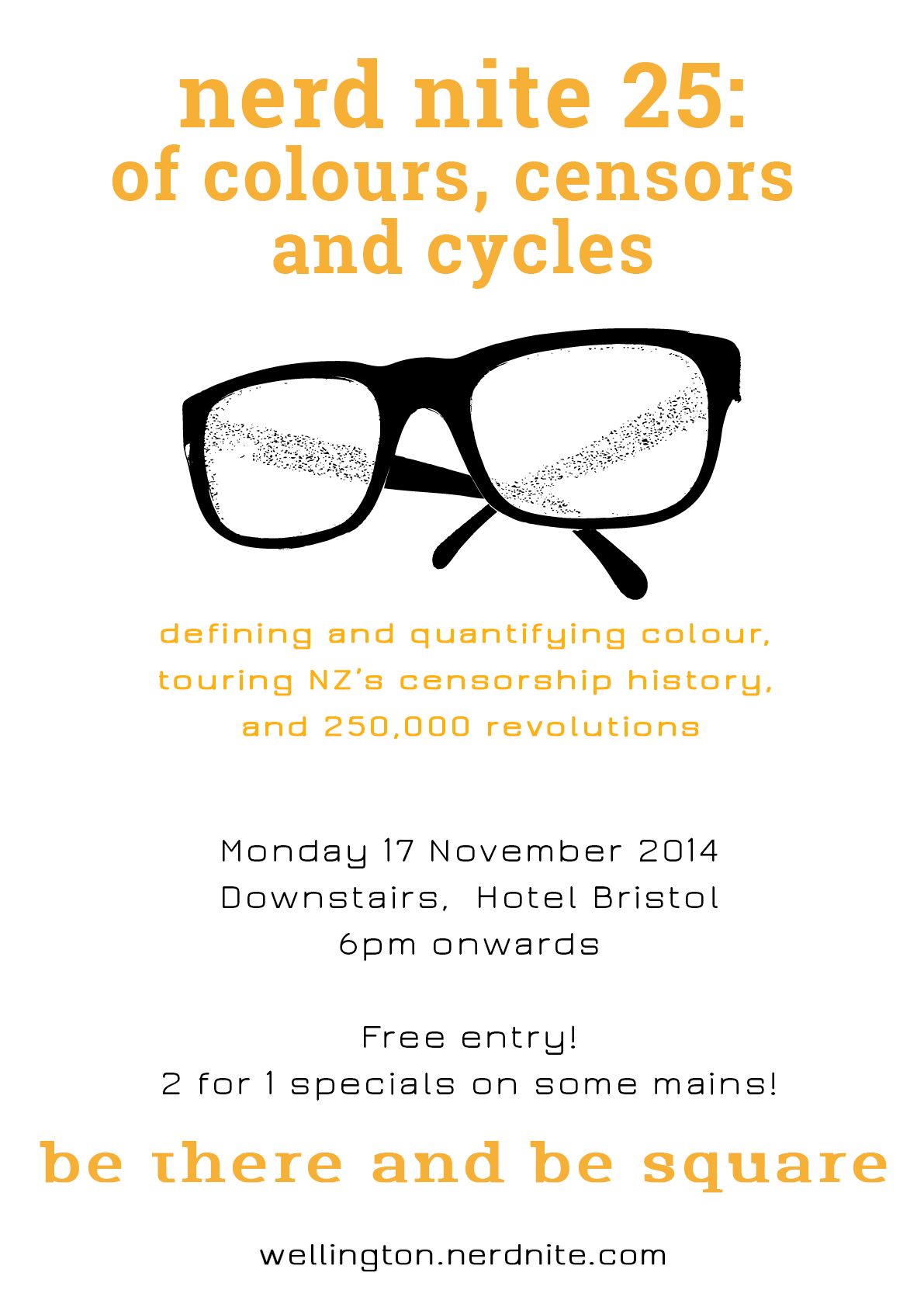Posts Tagged ‘science’
nerd nite 31: what’s growing in Wellington?
As usual, the awesome will be taking place at:
- Hotel Bristol (Cuba Street)
- 6pm (speakers to start at 6:30pm)
- Monday 23 November 2015.
As always, seating may run out, so don’t rock up at 6:30pm expecting to get a decent seat – or one at all.
What’s growing in Wellington?
Wellington Emerging Career researchers, @wtn_emcr
According to 2013 census data, Wellington has the highest percentage of people with university degrees of any region of New Zealand.
At this awesome edition of Nerd Nite Wellington, we’ll be featuring 3 emerging scientists from GNS, NIWA and Victoria University geeking out about their fields of expertise. Covering ocean physics, high temperature superconductors and understanding geothermal systems,Wellington’s wonderful young researchers will share their passion for their subjects and perhaps show you their science from a brand-new perspective.
Wellington is home to a plethora of research institutions including GNS Science, the Malaghan Institute for cancer research, NIWA, ESR and the MacDiarmid Institute. To name but a few. So one could reasonably expect that interesting scientific research happens here. Some of the city’s most interesting research, however, is being done by early career researchers (ECRs).
And this looks set to continue with support for ECRs central to the new Science for Technological Innovation national science challenge, presented as a cost-effective way of growing NZ’s creative capital. WECR (Wellington Emerging Career Researchers) is a small group representing the hundreds of scientists in Wellington within 10 years of completing their doctoral work.
—
LINEUP (note: speakers won’t necessarily appear in this order)
—
Home is where the hydrogen is
Lucy Stewart, GNS
Lucy will talk about correlating the presence of methanogenic microbes and hydrogen at hydrothermal vents, and how vents are useful as analogue study sites for astrobiology. She’s going to get into what hydrothermal vents are and where they’re found; how and why they support life; why methanogens are a particularly interesting kind of microbe at vent sites; and what her PhD research tells us about methanogens at hydrothermal vents, and how we can apply this knowledge to astrobiology and looking for life on other worlds.
Lucy Stewart completed her BSc(Hons) in microbiology at the University of Canterbury and her PhD in microbiology at the University of Massachusetts, Amherst, partially supported by a NASA Earth and Space Science Fellowship. She has returned to New Zealand to study the microbiology of Kermadec Arc volcanoes at GNS Science.
–
From ice to ice: ocean interactions with Antarctic ice
Natalie Robinson, NIWA
In an apparent paradox, sea ice around Antarctica has been expanding, despite forming in an ocean that is becoming warmer. Part of the answer to this puzzle lies in the effect that the warming ocean is also having on Antarctic ice shelves – the floating extension of the land-based ice sheet. Melting of ice shelves by the ocean creates water that becomes supercooled as it rises towards the surface. This very cold water contributes to thickening of sea ice, especially near to the coast. In this talk I will highlight some of the weird phenomena we have observed, and describe how they relate to the bigger climate picture in a warming world.
Natalie completed her MSc (VUW) and PhD (Otago) degrees in Antarctic Oceanography, and has recently been made part-time permanent at NIWA with a similar focus. She’s also diverged into other multi-phase systems, looking at explosive depositional processes and turbulence from fish in cages. With 3 young children, leisure time no longer exists, but in a previous life she enjoyed playing piano, long-distance running, salsa dancing and circus training.
–
Nano & neuro
Leo Browning, VUW
—–
As always, NNW is free and open to everyone*. Bring your friends and family – someone to share a meal with, definitely, as there are some great 2 for 1 specials on the menu.
* Who behaves themselves, of course. Naughtiness will be stamped on. Hard.
nerd nite 25: of colours, censors and cycles
Ladies and gentlenerds, we’ve reached A QUARTER CENTURY. Gosh 🙂
Our 25th Nerd Nite will take place on Monday November 17th, 2014.
Venue: Hotel Bristol
Time: 6pm, with speakers starting at 6:30pm. Get there in good time if you want a decent seat!
But enough nattering. Instead – our lineup!
—–
Is Periwinkle Blue? – Defining and Quantifying Colour
Jessica Mills, BFA
The world is full of colour, but we do not all see or describe colour in the same way. This indvidual initial classification is based on genetics, environmental factors, personal perceptions and experiences. So then, how can there be a single definition of colour and how is this definition measured in order to ensure repetition and reproduction in the controlled manner necessary for industrial, commercial, and artistic applications. In this talk we will explore these questions of Definition and Quantification, and you will hopefully come away with a deeper understanding of your visual perception of the world around you and seeing colour in a brand new way.
Jessica is a graduate of the Visual Media program of Rochester Institute of Technology, Rochester, NY, she has a Bacholor of Fine Arts in Photographic Arts and Sciences focusing on Colour Management and Digital Print Workflow. Prior to NZ Colour Management, Jessica has worked as an Applications Specialist for large international companies helping them and their external clients to create viable digital workflows based on software and hardware training and the principles of Colour Management.
—
What the **** – a brief tour through New Zealand’s censorship history.
Michelle Baker, @mshel
The effects on the audience, positive or negative, of media which our society produces and consumes has always been cause for debate. From the influence of the written word on perceptions of religion and politics, to the concerns over films chipping away at society’s moral fibre, to the debates over whether video games make people violent – the media, who accesses it and who stops them has been a constantly evolving and ongoing story both in New Zealand and around the world.
What our society deems to be okay – and not – is reflected in the way films, books and other publications are classified. New Zealand has had film censorship legislation since 1916, and there have been some interesting (and occasionally odd) decisions assigned to various things over the last nine or so decades. Do you know about the unusual (and unique) decision assigned to the 1967 film Ulysses? Why was a book of rugby songs banned? Just how many drink cans have been classified in New Zealand? Come on a brief tour of some of the highlights (or lowpoints?) of New Zealand’s censorship history.
Michelle is an Advisor at Office of Film and Literature Classification, where she runs the Office’s websites, social media, and handles all manner of inquiries from people. Movies and dinosaurs are a few of her favourite things, and she has strong opinions about what makes a good karaoke song.
—
Two hundred and fifty thousand revolutions
Paul Smith
Why would I choose to ride a bicycle with one gear and pedals that don’t stop turning, for seven days and 1200 kilometres around the back roads and trails of the South Island?
At the turn of the 20th century the hard men of a fledgling sport were racing the Tour de France along dirt roads over mountains on fixed gear bikes. But no more – gear and freewheel technology quickly resigned fixed gear bikes to mainstream obsolescence. But a fixed gear bicycle retains an enduring appeal – to a small subset of cyclists at least.
I’m going to attempt to describe the appeal of 100 year old bicycle technology with a rambling exploration of fixed gear bicycles, some dodgy psychological self-diagnosis, and the design philosophy of Dieter Rams. In the process I might leave myself wondering why I ride one.
Paul’s first cycling memory was screaming down Brickyard Hill on his 12” wheel Raleigh Striker. It didn’t end well – with a bloody chin and elbows, the bike dumped on the gravel road, and a small boy running home crying for mum. The experience didn’t put him off the two-wheeled life though, and he would be very proud if one of his kids came running to him with bleeding elbows. Professionally-speaking, Paul is a Design Engineer – by day he manages product testing at Consumer New Zealand, where he can indulge his love for good product design and engineering detail. By night he tries to encourage others to discover cycling adventures by documenting his experiences on www.inspiring-riding.com.
—–
As always, Nerd Nite is a FREE event open to anyone. There are some great 2 for 1 deals on mains as awell, so bring your peeps!
nerdnite 8 (special edition): Tell Us A Story
The first of many various and awesome special editions, master classes and so forth, we’re pleased as punch to present ‘Tell Us A Story’!
“Tell Us a Story” is Victoria University’s very first story-telling competition for Post Graduates in the Science and Engineering Faculties, with the aim being to ‘woo’ the audience. Not for this dry journal-type papers! Instead, stories of pain, passion, struggle and, likely, whiteboards and failed experiments*. In 7 minutes.
And nerdnite will be presenting the winning stories! Apparently, singing is allowed, although @teh_aimee insists she has veto rights over what is presented at nerdnite 😛
It’s all taking place on Monday, October 17th. At Club Ivy, from 6pm.
It’s gonna be aaaaawwweesome!
* Damn the little bastards for dying unexpectedly in their petri dish!

